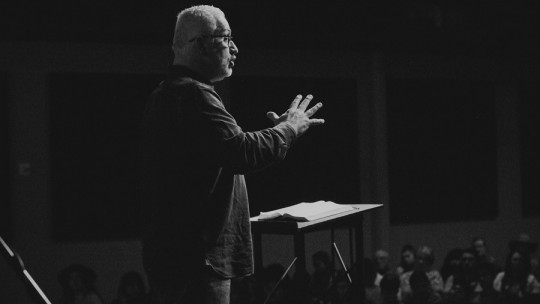
Surely, throughout your life, you have encountered the situation – or will find yourself – of having to speak in public, whether it is to present a work at the university, a thesis, a presentation or work conference, etc. .
Do you get nervous when facing these types of situations? Or do you feel satisfied with your public talks? Whether you want to improve, learn or mitigate your fears, In this article we propose 13 techniques to speak in public effectively
13 great techniques for public speaking
The 13 techniques for speaking in public, as we will see, have to do with different aspects of oneself and one’s own speech: verbal language, non-verbal language, attitude, etc. Let’s see what each technique consists of and how we should apply it properly:
1. Deep breathing
The first of the public speaking techniques that we propose is Breathe deeply before the talk, inhaling and exhaling little by little several times in a row This technique will help you feel more relaxed and will also provide oxygen to your brain so that your concentration increases.
When we breathe deeply, our abdomen swells; You can try putting your hand on it during inhalations and see how it fills with air, and then release it progressively. In addition to applying this technique before the talk, you can also do it during it; The important thing is to control your breathing and be aware of it.
2. Maintain eye contact
It is important to maintain eye contact (look into the eyes) with the attendees of your talk or presentation You don’t have to look at them penetratingly and constantly; It’s about looking at their faces while you talk.
As we will see throughout the article, non-verbal language is very important in these types of situations, since it accompanies the speech and enriches it.
3. Control your voice
When we speak in public, the voice should be moderate-loud (depending on the size of the room and the number of attendees); The important thing, however, is that the voice reaches the entire audience (from the first row to the last).
Thus, the volume of the voice is a very important aspect, but also the tone. Think that your voice is your main tool to transmit your message, and that it can give it intensity and conviction.
In this way, the voice has to change tone, intoning the key points of your speech.
4. Control the speed of speech
The speech does not have to be too slow or too fast ; thus, the speed should be moderate. This is important so that the speech is understood and the listeners do not lose the thread of the explanations.
5. Vocalize
Another technique for speaking in public is vocalizing This will allow you to transmit a clear message that reaches attendees and is clearly understood. Not vocalizing can mean that the message is not understood.
6. Maintain a positive attitude
As we see, “how you speak” is as or more important than “what you say.” Thus, Maintaining a positive attitude during your speech will make the message “soaked” in this positivity In this way, the message that will arrive will have more strength and vitality, and listeners will be able to be infected with this energy through your words.
Furthermore, negative thoughts (for example thinking: “I’m not doing well”, or “they’re getting bored”) will not help you, but on the contrary, they will make you more nervous and convey an image of insecurity (and this is very noticeable when you speak in public).
7. Be confident
The next of the public speaking techniques is to have confidence in yourself Trust is key to transmitting personal security and for attendees to believe in your message and support it. Additionally, in line with the previous technique, having positive thoughts will help you continue speaking with confidence.
Think that you are surely an expert on the topic you are going to talk about; you must think “no one knows it better than me, I can do it.”
8. Be sincere
Another technique for speaking in public is, simply, being sincere Sincerity, even if we don’t know it, is often transmitted, it is noticeable. Your goal should be to deliver a message that has some value, and that you believe in. To do this effectively, your attitude and words must reflect authenticity and transparency.
9. Focus
Try not to lose the thread of your speech, concentrating on each and every word you utter, as well as in your gestures and your non-verbal language. You have to focus on the present moment, on the “here and now”, since being aware of other things can harm your presentation.
In this way, being more aware of the audience than of your message can cause you to deviate from the topic without realizing it, or cause you to simply lose focus and lose the thread. This is why it is important to stay focused and not get distracted.
10. Control fear
The next of the public speaking techniques refers to controlling fear or shame All this is achieved, surely, thanks to the previous techniques, and with a lot of practice. When you are in control of fear or shame, you will be in control of the situation and your message will arrive effectively.
Additionally, you can try to have positive thoughts that help you remember that nothing bad is going to happen to you in this situation, and that your fears are irrational.
11. Control your body posture
As we said, non-verbal language is very important when we speak in public, since it is a tool that enhances and accompanies our message. So, Within this non-verbal language we find body posture; It should not be too rigid or too curved
We must be straight, with our shoulders relaxed and modulating our posture and our body based on our words.
12. Take care of your non-verbal language
A bit in summary, this technique includes some of the previous techniques for speaking in public Thus, taking care of gestures, voice, posture, tone, speed, eye contact, etc., will help us transmit a powerful, convincing and real message, so that our body is consistent with our words.
13. Practice
To finalize the public speaking techniques that will allow you to make an effective presentation, we propose the last technique: practice, practice and practice You can do it at home alone or in front of a family member or friend, and later include more people.
The important thing is that you expose yourself to the situation that makes you anxious (or simply that you gain experience in your speech). The more you practice, the more likely you will lose your embarrassment and your explanation will be complete and clear.








